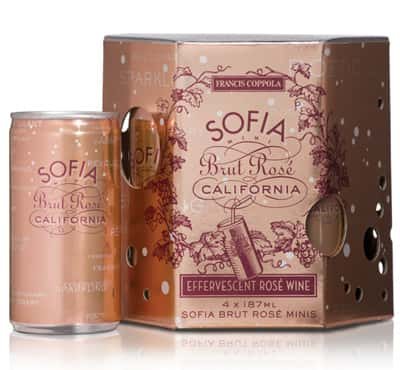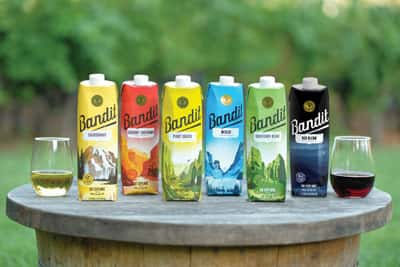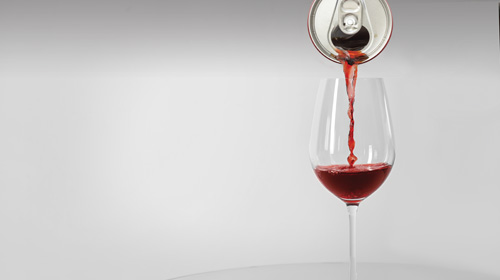Fine wine comes with certain expectations, and finding it in a bottle with a natural cork and an attractive label is likely to be close to the top of the list. Bottled wine undoubtedly has a certain allure. However, premium wines now come in containers other than glass and add convenience and sustainability to the sensory pleasure while maintaining its quality. As more consumers discover the benefits, alternative packaging is a trend on the upswing.
Cans
Although canned wine is increasing in popularity, it’s not entirely new. Francis Ford Coppola Winery in Geyserville became the first American winery to offer wine in cans when it released Sofia Blanc de Blancs Mini in 2004. A four-pack holds wine equivalent to the amount in a 750 L bottle. Production started slowly with 5,000 cases, and initial distribution began in test markets in San Francisco, New York and Miami. It was a new concept, and the packaging took time to catch on as a result of hesitation in the marketplace. But effective marketing and face-to-face encounters reached potential consumers, increasing production more than five-fold. “We can’t can enough,” says Tondi Bolkan, winemaker. “It’s been fun to see the evolution.”
The pioneering effort to put wine into cans had its challenges, and Coppola’s winemakers spent a year researching the best methods and overcoming obstacles. Sofia Blanc de Blancs in a bottle, for example, gets its characteristic effervescence from a second fermentation—Charmat Method—but a can is unable to withstand the pressure the process creates and would explode. The solution is to inject carbon dioxide into the wine to generate the requisite bubbles. In addition, because a can holds a much smaller amount of wine than a standard bottle, the bubbles don’t have to last as long, and are smaller. The goal is to maintain the wine’s character and provide the consumer with a consistent experience regardless of packaging. As a result, whether one opts for a can or bottle, “You hear the pop, and when you first put it to your mouth, it has a nice fizziness to it,” says Bolkan.
Some wines perform better than others in cans, and Coppola started with a white wine because it was easiest to control. Tasting panels determined what works best, and one of the findings was that oak makes wine in cans heavy. People who open a can of wine expect it to be light and refreshing, however. Consequently, Coppola decided to forego cans and reserve oaky wines for bottles. Aging also differs, and canned wine is meant to be sipped while it’s young. Once a wine is sealed in a container, its time clock for aging begins.
“These are definitely meant to be consumed sooner rather than later,” says Bolkan. “If it’s kept well, Sophia Minis are best when consumed within two years.” Bolkan keeps canned wine in a wine refrigerator at 40 to 50˚F so it’s chilled and ready to serve, but a regular refrigerator would also suffice. Above all, “Don’t put it in a really warm or hot place,” she advises. “You have to think of the can like a stainless steel tank located at a winery—always under temperature control.”
One of canned wine’s biggest advantages is its portability, something Coppola learned from social media. They discovered that people were taking Sofia Minis to places like the beach or on hikes. Subsequently, they decided to expand their offerings to give buyers more choices. “If our Sofia fans were taking it on their adventures, why not more?” asks Bolkan. Thus, in August 2018, Coppola began offering the Diamond Collection, which offers Pinot Noir, Chardonnay, Sauvignon Blanc and Pino Grigio in cans, joining Sofia Blanc de Blancs Mini and Brut Rosé Mini.
They discovered that people were taking Sofia Minis to places like the beach or on hikes. Subsequently, they decided to expand their offerings to give buyers more choices. “If our Sofia fans were taking it on their adventures, why not more?” asks Bolkan. Thus, in August 2018, Coppola began offering the Diamond Collection, which offers Pinot Noir, Chardonnay, Sauvignon Blanc and Pino Grigio in cans, joining Sofia Blanc de Blancs Mini and Brut Rosé Mini.
While ease is a factor in canned wines, they’re also a better choice for certain occasions. JaM Cellars in Napa, the presenting sponsor of BottleRock Napa for several years and again in 2019, finds that in a setting such as a music festival, wine in single-serving cans results in less waste because the containers are recyclable. Their use also avoids the hazard of broken glass on festival grounds. “We see ourselves more as a lifestyle brand than a wine brand,” says Liza Butler, vice president of design and product development. That’s reflected in JaM’s downtown Napa location, which has a music studio that doubles as a tasting room.
John and Michele Truchard, second-generation Napa Valley vintners, are the “J” and “M” in JaM Cellars, launched in 2009 as part of the John Anthony Family of Wines in response to the impact of the recession that began in 2008. People weren’t spending money on ultra-premium wines, and in considering the possible long-term impact of flagging sales, the Truchards wanted to find a more accessible product—specifically a great quality wine that was under $20 per bottle. JaM Cellars started with a Napa Valley Cabernet Sauvignon, JaM Cabernet, in 2009, and then decided to make a white wine called Butter Chardonnay. Toast Sparkling came next, and on Valentine’s Day, 2017, JaM released California Candy Dry Rosé. With unconventional names, bright labels and bold lettering, the wines found an audience. “We had triple-digit growth in our early years,” says Sarah Montague, chief marketing officer. Meanwhile, non-traditional formats were growing, and they decided to put Butter into cans. “Butter is one of those brands that’s fun and non-pretentious,” says Montague. They made 7,000 cans to see if people liked them, and the interest was huge. ButterCans launched in August [2018] and consumers wanted them right away. “People were tasting Butter out of a can and loving it,” says Montague.
JaM does much of its marketing on social media and has a large community on Facebook and Instagram. In addition, sponsorships at music festivals are a way to cultivate fans. “That tends to be a way to connect with our Butter lovers. We can talk about our wines constantly, because there’s always some sort of music festival we’re associated with throughout the year,” says Montague. ButterCans are in stores in four-packs, in accordance with regulations set forth by the Alcohol and Tobacco Tax Trade Bureau, a division of the United States Department of Treasury. “Consumers can now find them for whatever the occasion. They’re really easy and delicious to take on a picnic or around and about,” says Montague. “We’re basically tripling production in cans in the next year.”
Cartons
Charles Bieler, Joel Gott and Roger Scommegna started bottling wine as Three Thieves Wine in 2001, taking an unconventional approach to packaging by offering a 1 L jug of Zinfandel with a screw cap. Then, in 2004, they started Bandit Wines (which became a brand of Trinchero Family Estates in St. Helena in 2005) to put several varietals in Tetra Pak cartons. Scommegna had seen the cartons in Italy, and while they were a big segment of wine sales in supermarkets there, they hadn’t yet reached the United States. “We were the first,” says Bieler. Among the challenges, the packaging required particular specialized equipment, and no one who had it was licensed to package wine. As a result, they had it packaged in Italy until they convinced some American facilities to get licenses. An even bigger challenge was changing consumer’s notions that packaging other than glass somehow suggests lower quality. “You can have a big, heavy bottle with poor wine. You can put beautiful wine in other containers,” says Bieler. “It has nothing to do with the container.“
The concept of cartons got the attention of the three partners because it fit their ethos well. It eliminated the cost of glass and cork, and as big believers in value, they could pass on the reduced packaging costs to the consumer. The idea that they could throw a carton of wine into a backpack and not worry about breakage or the extra weight a glass bottle adds was appealing as well. Equally important were the environmental benefits of low-impact packaging. Bieler points out that while glass is a beautiful, historic container, it’s heavy and has to be shipped thousands of miles to the location where the wine is produced, thus using a substantial amount of fossil fuels. Tetra Pak is made mostly of paper, with a liner to protect the wine, and it’s a renewable resource that’s light and recyclable. “It’s like nature’s most perfect package,” says Bieler. He points out that even if people don’t recycle the cartons, the impact on landfills is less because most of the material in the carton will degrade.
 California Natural Products of Lathrop, near Stockton, now packages Bandit’s wines. The process begins with the arrival of a giant roll of printed paper that’s set into special equipment that cuts the paper to size and fills the carton with wine. “It keeps the contents incredibly fresh. It’s not like bag in a box, and it’s not like cans. It holds up essentially like a bottle,” says Bieler. He adds that the wine has a high turnover and isn’t made for aging. He recommends storing it in a cool place and serving it within a year or two of purchase.
California Natural Products of Lathrop, near Stockton, now packages Bandit’s wines. The process begins with the arrival of a giant roll of printed paper that’s set into special equipment that cuts the paper to size and fills the carton with wine. “It keeps the contents incredibly fresh. It’s not like bag in a box, and it’s not like cans. It holds up essentially like a bottle,” says Bieler. He adds that the wine has a high turnover and isn’t made for aging. He recommends storing it in a cool place and serving it within a year or two of purchase.
Two years ago, Bandit added images of national parks to its cartons and saw an immediate increase in sales. “Adding the images is a beautiful, emotive thing. It helped address something I’d been struggling with,” says Bieler, who was raised by a Hippie mom and spent time in the mountains growing up. He wanted to address environmental responsibility, but in a way that’s not scolding. He believes the images set a tone visually that might make people think about the environment. “I hope there’s a little bit of reflection,” he says. Meanwhile, he reports that cartons are one of the fastest growing categories in wine sales. “At first, we were alone, and it was challenging. In the early days, it was the most bizarre thing people had ever seen. Those days have been over for a decade. I’m so proud of the development of the category.”
On tap
Chances are, if someone orders a glass of wine in a restaurant, it will come from a tap, and in the long journey from vat to glass, attention to preserving a wine’s quality and freshness is foremost. Francis Ford Coppola Winery has been offering wine in kegs to restaurants for several years. “They show well and last longer,” says Bolkan, who explains that the wines are kept under pressure, and the system eliminates problems with head space and oxidation. The process starts when the winery puts wine that is sterile, filtered and clean into a tanker truck similar to those that carry milk. The wine goes to Free Flow Wines in Napa, which is a specialist in both kegging and canning wines and provides services for 180 wineries and 300 brands.
Jordan Kivelstadt, founder and president of Free Flow Wines, says the company started as Silver Tap in a garage in San Francisco in 2009, and it kegged the very first premium wine on tap. The company spent the years from 2010 to 2012 in research and development to find the best way to get wine from the keg to a glass and deliver a great glass of wine every time. An additional challenge was learning how restaurants should serve wine on tap and teaching bartenders how to handle kegs and solve any problems they might encounter. “We had to change a whole culture,” he says. Once consumers experienced kegged wines, they liked them, and restaurants wanted more. The wineries, however, asked for help with putting their wine in kegs. In response, Kivelstadt sold Silver Tap to focus exclusively on Free Flow. “The idea for Free Flow was born out of that common desire of wineries and operators for the service,” he says.
When Free Flow receives wines from the winery, they’re already blended and barrel-aged, and include the winery’s specifications for packaging the wine as the winemaker intends. “We’re receiving the finished wine,” says Kivelstadt. Free Flow ensures that everything remains the same as it was when it left the winery. He adds that bigger tannic wines and those that need aging don’t do well in kegs. Free Flow also shies away from sparkling wines because they are more challenging to dispense.
Among the advantages of wine on tap are its consistency. “You never have a spoiled bottle you have to dump out,” says Kivelstadt. He points out that it increases profitability, and it’s kept at the correct temperature, allowing a fresh, temperature-perfect glass of wine to increase a customer’s enjoyment. Kegs are also more efficient for bartenders, who don’t have to stock bottles, open them and dispose of them when they’re empty. Kegs are also sustainable, because they’re made of stainless steel, can be reused for 30 years and then recycled.
Destination
Farmshop at Marin Country Mart in Larkspur boasts rows of shiny glasses beneath gleaming custom-made taps behind the bar, and Russell Sheldon, the restaurant’s beverage manager, says that wine on tap is increasingly popular. Requests for it outnumber bottles, and people ask for it because it’s eco-friendly. The increased demand means that a greater number of higher-end labels are making their wines available in kegs.
Kegs have substantial advantages for restaurants. “One of the biggest benefits is storage,” says Sheldon. Kegs are easy to store and don’t take up shelf space. Bartenders prefer tap wine because it’s easy. “You can pour a lot of wine by the glass very quickly, and you can switch it [a keg] out in under a minute,” says Sheldon. In addition, a winery’s costs are less, because they don’t have to clean, fill, close, label and transport individual bottles. One keg holds the equivalent of 22 bottles, and it doesn’t oxidize, so it has a longer shelf life, and a restaurant isn’t under pressure to move it quickly. Sheldon says a keg eliminates costs and labor at a wine’s source, and that all gets passed on to the restaurant. “The winery saves; the restaurant saves; and the consumer saves,” he says.
Farmshop offers six wines on tap—three red and three white— and they’re all stored in cellars with similar wines in bottles, so they stay at the appropriate temperature. “You wouldn’t be able to differentiate which is a tap wine and a bottle wine,” says Sheldon. It’s part of a new approach to packaging that makes premium wines more accessible. Quality, convenience and sustainability are all considerations. Wine in cans, boxes and kegs are meeting a wider range of needs than ever before. And everyone benefits all along the line.
Bandit’s Tetra Paks
Fuel efficient. It takes 52 semi-trucks to transport one million empty bottles, but just two to carry one million empty Bandit cartons.
Made almost entirely of paper—a resource that can be regrown or produced without depleting natural resources.
Holds 50 percent more wine than a traditional wine bottle.
A smaller environmental impact and carbon footprint because it takes less energy to produce and package wine with them.
Completely made of recyclable materials.
Available in seven varietals: Pinot Grigio, Chardonnay, Sauvignon Blanc, Dry Rosé, Merlot, Cabernet Sauvignon and Mixed Red.
Source: Bandit Wines
About Cans
Ball Corporation, headquartered in Colorado with locations around the world, is a leader in producing aluminum cans for wine and other beverages.
• Aluminum cans prevent 100 percent of exterior oxygen from entering, thus preventing them from contaminating the product inside.
• It takes 15 12-oz. cans to equal the weight of one 12-oz. bottle.
• Cans completely block light penetration, unlike amber glass, which lets in 5-percent.
• Empty beverages can be recycled, filled and put back on store shelves within 60 days.
Source: Ball Corporation
About Kegs
One 19.5 L stainless-steel keg
• Eliminates 26 empty wine bottles, corks labels and cardboard boxes from either going to a landfill or being recycled.
• Holds 132 5 oz. glasses of wine.
• Measures 24 inches tall and 9.25 inches wide.
• Weighs 58 pounds when full, and 14 pounds when empty.
• Is 100 percent reusable.
Source: Free Flow Wines




